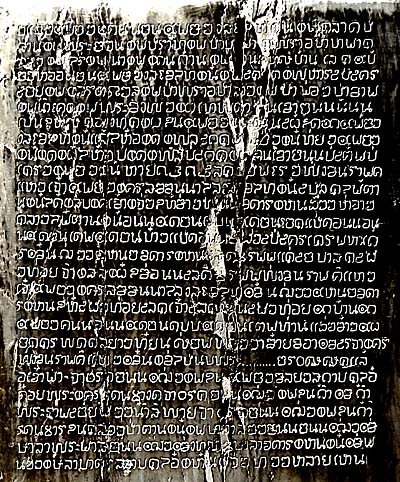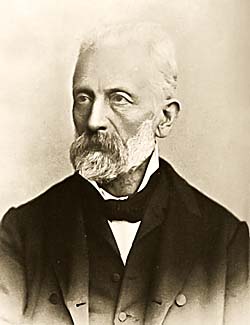3.
Adolf Bastian's Works, Ideas and Theories
Alone six volumes of Bastian's work are dedicatet to 'The People of East Asia' (1866 - 1871), and there are more of his writings on Southeast Asian topics as Buddhism or the famous 'inscription no. 1' of Sukothai.
All his many publications contain detailed descriptions of the ethnics Bastian came in contact with. Often he is comparing very different peoples and their customs and particularly their mythologies. That includes also ancient cultures like the old Greek and Egyptians. Since his work is extraordinarily full with ideas, it's not always easy to get a clear picture of his theories. His books and essays are also not easy to read; most of his manyfold implications remain unexplained and are therefore not understandable for a non ethnologist outsider. Bastian's scientific reception is impaired by that since today.

The inscription no. 1 on the famous Ramkamhaeng stela in Sukothai. The inscription is a cornerstone in the modern narrative of Thai history. Adolf Bastian wrote an elaborate essay on the inscription. The stela in Sukothai is, by the way, a replica; the original is placed in the National Museum in Bangkok. Image by Asienreisender, 2013
Bastian emphasized the 'unity of human mind' (he called it 'Elementargedanken'). According to this idea different peoples in all the different cultures all over the world show only a small variability in their basic world reception. The Swiss psychologist Carl Gustav Jung adapted and developed Bastian's 'Elementargedanken' to the concept of the psychological 'archetypes'.
Societies in their geographic distribution with all the peculiar influences of different landscapes, climates and local histories differ apparently. People organize in response to that their social structures and mindsets. That shapes the cultural differences between the ethnics in different regions of the world. Bastian called that 'Völkergedanken' ('folk ideas').
Studying a great number of different ethnics around the world, Bastian concluded the 'folk ideas' as secondary to the 'Elementargedanken' of human's psychic unity. The secondary layer, so to say, can only grow exclusively on the very basic layer. That explains the many congruencies of myths, legends, sagas and religious ideas of cultures in very different locations on the earth or over long periods of history (the old Romans or Carthageans).
Bastian critizised Darwin's 'theory of evolution' and followed instead the theory of 'evolutionism'. Evolutionism describes the development of all different human societies in the way of a higher (kind of linear) development. The highest stage in this concept reached the industrialized European (and north American) societies. Evolutionism is therefore critisized as eurocentric. It seems also somewhat teleological.
Adolf Bastian's approach to ethnology was a scientific one, influenced by the naturalist tradition of Alexander von Humboldt and Johann Gottfried Herder. Detailed obervations, as they are manyfold expressed in his rich works, were the empirical basics for his studies. Bastian was particularly eager to study and document foreign cultures before they would come under European (colonial) influence and adapt to it. He was fully aware of the threat, respectively process of extinction, for these cultures which came from European colonialism and called it's spread over the world a world fire ('Weltbrand').
One of the great merits of Bastian's work is the valuable collection of ethnic research results among native people who were still widely untouched by western civilization. Nowadays such an approach is completely impossible. Almost all of the different people in the world are completely overlayed by the poisonous impact of western capitalism. The former local cultures are, so far there are still traces of them left, merely adapted, distorted and submerged to westernization.
Nevertheless, Adolf Bastian's documentary approach gave some cause for critics who claimed his work lacks structure and systematic empirical studies.
Adolf Bastian died in 1905 in one of his voyages in Trinidad. His remains were later brought to Germany and burried in Berlin.


